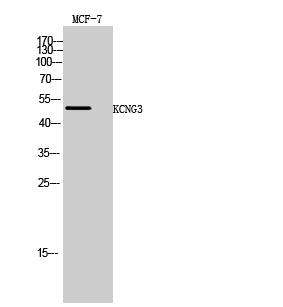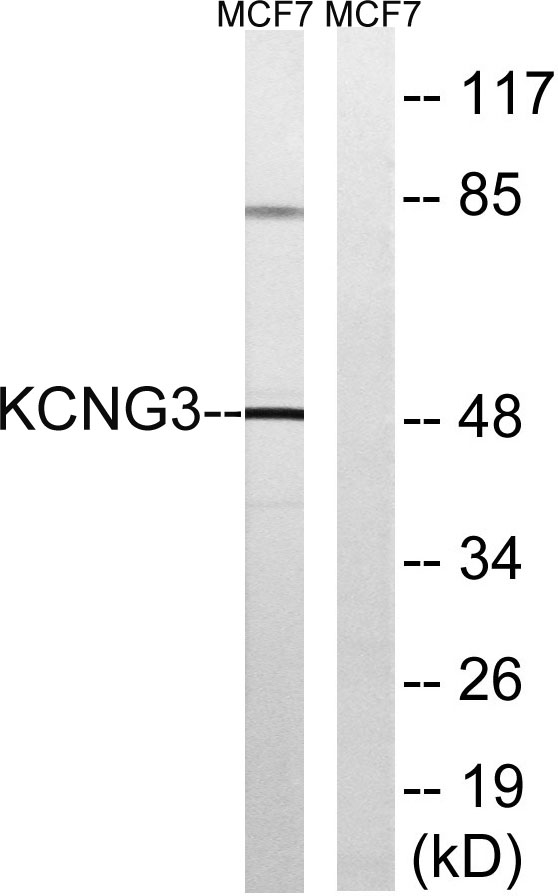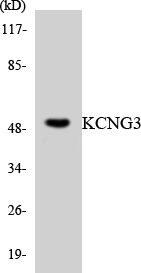KCNG3 Polyclonal Antibody
- Catalog No.:YT2455
- Applications:WB;IHC
- Reactivity:Human;Mouse;Rat
- Target:
- KCNG3
- Gene Name:
- KCNG3
- Protein Name:
- Potassium voltage-gated channel subfamily G member 3
- Human Gene Id:
- 170850
- Human Swiss Prot No:
- Q8TAE7
- Mouse Gene Id:
- 225030
- Mouse Swiss Prot No:
- P59053
- Rat Gene Id:
- 171011
- Rat Swiss Prot No:
- Q8R523
- Immunogen:
- The antiserum was produced against synthesized peptide derived from human KCNG3. AA range:183-232
- Specificity:
- KCNG3 Polyclonal Antibody detects endogenous levels of KCNG3 protein.
- Formulation:
- Liquid in PBS containing 50% glycerol, 0.5% BSA and 0.02% sodium azide.
- Source:
- Polyclonal, Rabbit,IgG
- Dilution:
- WB 1:500-2000;IHC 1:50-300
- Purification:
- The antibody was affinity-purified from rabbit antiserum by affinity-chromatography using epitope-specific immunogen.
- Concentration:
- 1 mg/ml
- Storage Stability:
- -15°C to -25°C/1 year(Do not lower than -25°C)
- Other Name:
- KCNG3;Potassium voltage-gated channel subfamily G member 3;Voltage-gated potassium channel subunit Kv10.1;Voltage-gated potassium channel subunit Kv6.3
- Observed Band(KD):
- 50kD
- Background:
- Voltage-gated potassium (Kv) channels represent the most complex class of voltage-gated ion channels from both functional and structural standpoints. Their diverse functions include regulating neurotransmitter release, heart rate, insulin secretion, neuronal excitability, epithelial electrolyte transport, smooth muscle contraction, and cell volume. This gene encodes a member of the potassium channel, voltage-gated, subfamily G. This member is a gamma subunit functioning as a modulatory molecule. Alternative splicing results in two transcript variants encoding distinct isoforms. [provided by RefSeq, Jul 2008],
- Function:
- domain:The segment S4 is probably the voltage-sensor and is characterized by a series of positively charged amino acids at every third position.,function:Potassium channel subunit. Modulates channel activity.,similarity:Belongs to the potassium channel family. G subfamily.,subcellular location:Has to be associated with KCNB1 or possibly another partner to get inserted in the plasma membrane. Remains intracellular in the absence of KCNB1.,subunit:Heteromultimer with KCNB1, KCNC1 and KCNF1. Does not form homomultimers.,tissue specificity:Detected in many parts of the brain with the exception of the cerebellum, in testis, pancreas, lung, kidney, ovary, small intestine, colon, thymus, adrenal gland and spinal cord.,
- Subcellular Location:
- Cell membrane ; Multi-pass membrane protein . Cytoplasm . Has to be associated with KCNB1 or possibly another partner to get inserted in the plasma membrane (PubMed:12060745). Colocalizes with KCNB1 at the plasma membrane (PubMed:12060745, PubMed:19074135). Remains intracellular in the absence of KCNB1 (PubMed:12060745). .
- Expression:
- Expressed in the brain, liver, testis, small intestine, colon, thymus and adrenal gland (PubMed:11852086, PubMed:12060745).
- June 19-2018
- WESTERN IMMUNOBLOTTING PROTOCOL
- June 19-2018
- IMMUNOHISTOCHEMISTRY-PARAFFIN PROTOCOL
- June 19-2018
- IMMUNOFLUORESCENCE PROTOCOL
- September 08-2020
- FLOW-CYTOMEYRT-PROTOCOL
- May 20-2022
- Cell-Based ELISA│解您多样本WB检测之困扰
- July 13-2018
- CELL-BASED-ELISA-PROTOCOL-FOR-ACETYL-PROTEIN
- July 13-2018
- CELL-BASED-ELISA-PROTOCOL-FOR-PHOSPHO-PROTEIN
- July 13-2018
- Antibody-FAQs
- Products Images

- Western Blot analysis of MCF-7 cells using KCNG3 Polyclonal Antibody

- Western blot analysis of lysates from MCF-7 cells, using KCNG3 Antibody. The lane on the right is blocked with the synthesized peptide.

- Western blot analysis of the lysates from HeLa cells using KCNG3 antibody.

- Immunohistochemical analysis of paraffin-embedded human Squamous cell carcinoma of lung. 1, Antibody was diluted at 1:200(4° overnight). 2, Tris-EDTA,pH9.0 was used for antigen retrieval. 3,Secondary antibody was diluted at 1:200(room temperature, 45min).



